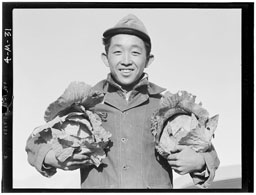PORT TOWNSEND — Pictures of one of the nation’s darkest moments, captured by a famous photographer, are part of a new show at the Jefferson Museum of Art & History.
“Ansel Adams: A Portrait of Manzanar” looks into the eyes of the men, women and children ordered to leave their homes and farms — in places such as Bainbridge Island and Jefferson County — for a California relocation center.
Adams traveled to Manzanar in 1943 and was given two ground rules: no pictures of the barbed wire or the guard towers.
The internment experience, though, comes through clearly in the faces of the internees, said Bill Tennent, director of the Jefferson County Historical Society.
Tennent, who brings the Ansel Adams exhibit from the Bainbridge Island Historical Museum to Port Townsend, will open it with a ribbon-cutting at 11 a.m. Saturday.
The show will stay until Aug. 18 at the Jefferson Museum, which is open daily from 11 a.m. until
4 p.m. at 540 Water St.
Admission is $4 for adults and $1 for children 12 and younger, except on the first Saturday of each month, when it’s free for Jefferson County residents.
In “Portrait,” Tennent noted, Adams’ focus is on the internees’ personal experiences after arriving at Manzanar, some 200 miles northeast of Los Angeles.
Before closing at World War II’s end in 1945, the camp’s population peaked at 10,000 people.
Manzanar opened 70 years ago, one of several camps set up after President Franklin D. Roosevelt issued the evacuation edict known as Executive Order 9066.
Bainbridge Island’s Japanese-Americans were the first to be affected when Civilian Exclusion Order No. 1 was posted March 24, 1942.
The farmers and fisherfolk were given six days to register, pack, sell or somehow rent their homes, farms and equipment.
“On Monday, March 30 at 11 a.m., these Japanese Americans, under armed guard, were put on the ferry Keholoken to Seattle where they boarded a train to Manzanar,” according to an article on the University of Washington website, www.Lib.Washington.edu.
They were instructed to bring blankets and linens, toiletries, clothing, knives, forks, spoons, plates, bowls and cups for each family member, packaged “in accordance with instructions received at the Civil Control Office.”
Adams went to Manzanar in the fall of 1943.
The massive relocation was brought home to him when Harry Oye, a Japanese-American and his parents’ longtime employee in San Francisco, was taken into custody by authorities and sent away to a hospital in Missouri.
Adams later donated hundreds of his prints and negatives — of family life in the barracks, of camp welders, farmers and garment makers, and of baseball and volleyball games — to the Library of Congress.
Today, that collection, “Suffering Under a Great Injustice: Ansel Adams’s Photographs of Japanese-American Internment at Manzanar,” can be seen free at www.LOC.gov.
The photographs are nowhere near as well-known, of course, as Adams’ images of Yosemite National Park, the Sierra Nevada and the Taos Pueblo.
When he first offered them to the Library of Congress in 1965, he noted his reasons for working at Manzanar, a place he called “arid but magnificent.”
“The purpose,” Adams wrote, “was to show how these people, suffering under a great injustice, and loss of property, businesses and professions, had overcome the sense of defeat and dispair [sic] by building for themselves a vital community . . . All in all, I think this Manzanar Collection is an important historical document, and I trust it can be put to good use.”
In Port Townsend, the Jefferson County Historical Society is mounting an excerpt of Adams’ collection — plus a companion exhibit.
This second display documents the experience of the 27 Japanese-Americans removed from Jefferson County and is on view in Port Townsend City Council chambers at 540 Water St.
As always, the historical society will host a First Friday lecture as part of its new show, so Clarence Moriwaki, president of the Bainbridge Island Japanese-American Exclusion Memorial Association, will give a photo-illustrated talk at 7 p.m. Aug. 3. Admission is a suggested $5 donation.
For more details about these exhibits and museum activities, visit www.JCHSmuseum.org or phone 360-385-1003.
Features Editor Diane Urbani de la Paz can be reached at 360-452-2345, ext. 5062, or at diane.urbani@peninsuladailynews.com.

